|
Iron Fireman Manufacturing Company During World War Two
Portland, OR
1923-1974 when purchased by Boeing
Cleveland, OH
1929-2000
Franklin Park,
Illinois
2000-2011
This page updated 12-8-2024.
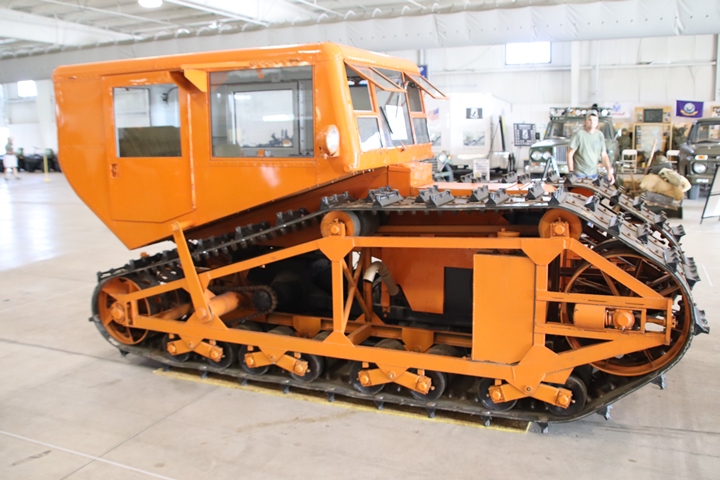
What a cool and unique vehicle! I
almost did not take the opportunity to see and learn about this at the
MVPA-HA National Convention at Oshkosh, WI which took place August
12-14, 2024. I had been debating for the past several weeks as to
whether I wanted to make the long journey to the convention. I was
unsure of how it would provide anything new of interest to me. Of
late, MVPA conventions and shows, both national and local, have seen a
decrease in World War Two vehicles and an increase in more modern
military vehicles. I am interested in World War Two vehicles and
the post war military vehicles are not of much interest to me. In
the end, I decided to make the trip because there was also the EAA
Museum, and the Military Veterans Museum located within a couple of
miles of where the MVPA convention was being held on the EAA grounds.
Both of these museums, along with the few added items I saw at the MVPA
convention, made the trip worthwhile.
Had I not gone, I would never have seen this
very unique T36 snow tractor built by the Iron Fireman Company of
Portland, OR. I would not have learned about the company, had a
chance to research it, nor learn how it helped win World War Two.
While the T36 is an interesting product, the company produced 7.6% of
the 2,500 hp triple reduction steam engines used in the very important
Liberty cargo ships of World War Two. The Liberty ship engines
were where the Iron Fireman Company made the most important contribution
to winning World War Two.
When I first saw the company name of Iron
Fireman, I thought of a firefighter. But the name of the company
goes back to when coal was the main heating fuel in the United States.
The "Fireman" in the name references the person who stoked and fed coal
into the furnace. Steam locomotives all had an operator called a
fireman to do this. Once I learned that the company made
mechanical stokers, its name made sense. It is also a name that is
easily remembered.
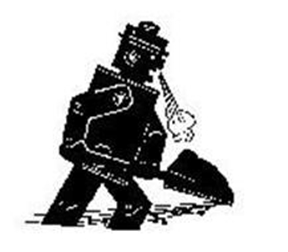
The company's logo consisted of an iron
fireman shoveling coal.
The History of Iron
Fireman:
In 1923 Thomas Harry Banfield and Cyrus Jury
Parker took over an iron works in Portland, Oregon that was
manufacturing a small coal stoker that automatically fed coal to the
furnace. Relatively quickly, they found out it didn’t work very well, so
the men redesigned it and named it the Iron Fireman®. U.S. Patent and
Trademark Office (USPTO) records indicate that, according to information
provided by the company, the name and logo were first used, and first
used in commerce, on July 1, 1923. The USPTO records also suggest that
the name and logo were first registered as trademarks sometime in 1925.
Relatively quickly, it became a commercial success. In 1928 both men
were involved in an air crash which claimed Parker’s life. Banfield
recovered and succeeded Parker in company leadership.
The automatic coal stokers were used for both
residential and commercial building furnaces. The product designed
for homes, which was called the Iron Fireman Jr., eliminated the need for someone to have
to periodically shovel coal into the furnace, all day and all night. We
did not have one of these in our first house, which was originally coal
fired. I remember going down in the basement when I was really
young to watch my father shovel coal into the furnace from the coal bin.
He also had a long steel rod with a hook on the end of it to stoke the
fire. My parents converted to natural gas just before or while I
was in kindergarten.
In industry, it was a labor savings as men
were no longer needed to tend fires and stroke the steam boilers. Coal
was the heating fuel of choice for the first half of the century in this
country. Therefore, the Iron Fireman was a product sought after by
both home owners and commercial companies.
In 1945, the coal stoker business of the
Portland plant was moved to Cleveland, OH and consolidated with that
plant's oil burner business. However, this was not the end of the
Iron Fireman plant in Portland. The plant switched product lines
and began making aerospace products for Boeing aircraft and USAF guided
missiles. The Portland site became known as the Portland Division
of the company. In 1961 the company merged with the
Electronic Specialty Company (ESCO). After the merger, the
Portland plant continued to produce aerospace components until it was
purchased in 1974 by Boeing.
Following World War Two, the company developed oil fired burners at
their Cleveland facility and consolidated the business at that location.
By 1960 Iron Fireman had a commanding presence in commercial power
burner sales – reportedly about 60% of the US market. Because coal had
lost its place as the major heating fuel to oil and natural gas, the
coal stoker business was sold to the Will-Burt company in 1966.
In 2000
Iron Fireman was acquired by Vapor Power, who moved operations to
Franklin Park, Illinois. It operated there until production ceased in
December 2011. Vapor Power then sold all remaining assets for
burners of the Iron Fireman business to OEM Boiler Parts Inc., of
Elizabethtown, PA, including all engineering and sales records, parts
inventory, and production tooling.
This
page will focus on the original Portland, OR operation of the company.
The Iron Fireman Manufacturing Company's World War Two Products:
Even before the United States entered World War Two, the Iron Fireman
Manufacturing Company was making both aluminum and steel machined
components for use on Boeing B-17 Flying Fortresses. In August
1940, Boeing was awarded a $130,000,000 contract from the USAAF for 512
B-17Es. The Iron Fireman Manufacturing Company then received a
$1,200,000 contract from Boeing to produce 700 machined part numbers for
the 512 B-17Es. The Iron Fireman Manufacturing Company then
purchased 100 machine tools worth $250,000 to be able to produce the
parts for Boeing. By April 1941, the company had 200 machinists
working 24 hours a day, five days a week, turning out the B-17
components. Concurrently, the company also had 200 workers making
coal stokers. The Iron Fireman Manufacturing Company also
purchased a second plant with 16,000 square feet of floor space for its
new machine tools.

The first defense contracts awarded to the
Iron Fireman Manufacturing Company were with the Boeing Company to
produce 700 different machined parts, both steel and aluminum for
the 512 B-17Es like this one on display at the National WWII Museum in
New Orleans, LA. Image courtesy of Ronyeh.
Table 1 shows that the Iron Fireman
Manufacturing Company's Cleveland, OH plant was awarded $2,163,000 in
major contracts during World War Two. Table 2 shows that the
Portland, OR plant had $42,878,000 in major contracts during the war.
Its largest contract was for $36,875,000 for the engines used in the
Liberty ships. This one contract was 86% of the total major
contracts the company received for the war effort. Table 4
indicates that the Iron Fireman Manufacturing Company produced 209
Liberty ship engines in 15 months during 1942-43. This was 7.6% of
the total engines required.
In 1942, the company became one of twenty
companies that formed Oregon War Industries, Inc. in Portland, OR.
This organization pooled resources in order to obtain war contracts that
the smaller companies may not have been awarded on their own. It
also allowed member companies access to other company's facilities when
needed to complete a contract.
The Iron Fireman Manufacturing Company is
another prime example of many companies during World War Two that
manufactured products totally unrelated to their peacetime product line.
The company's production of B-17 aircraft components, 250,000 lb.
Liberty ship engines, snow tractors, and bomb fuzes shows that the
company produced a wide variety of products to help win World War Two
totally unrelated to its peacetime coal stokers.
Table 1 - Iron Fireman
Manufacturing Company's
Major World War Two Contracts - Cleveland, OH Plant
The information below
comes from the "Alphabetical Listing of Major War Supply
Contracts, June 1940 through September 1945." This was
published by the Civilian Production Administration,
Industrial Statistics Division, Requirements and Progress
Branch January 21, 1946. |
|
Product |
Contract Number |
Contract Amount |
Contract Awarded
|
Completion
Date |
| Mounts Gun -
Army Ordnance |
303-ORD-1201 |
$595,000 |
1-1942 |
9-1942 |
| Mounts Gun -
Army Ordnance |
303-ORD-1493 |
$705,000 |
4-1942 |
11-1942 |
| Metal Amm
Containers - Army Ordnance |
33019-ORD-1475 |
$500,000 |
2-1944 |
12-1944 |
| Salvage
Equipment - Maritime Commission |
WSA-1331 |
$259,000 |
12-1944 |
6-1944 |
| Riveting Gun
Kits - Army Corps of Engineers |
30082-ENG-4966 |
$104,000 |
3-1945 |
5-1945 |
| Total |
|
$2,163,000 |
|
|
Table 2 - Iron Fireman
Manufacturing Company's
Major World War Two Contracts - Portland, OR Plant
The information below
comes from the "Alphabetical Listing of Major War Supply
Contracts, June 1940 through September 1945." This was
published by the Civilian Production Administration,
Industrial Statistics Division, Requirements and Progress
Branch January 21, 1946. |
|
Product |
Contract Number |
Contract Amount |
Contract Awarded
|
Completion
Date |
| Equipment
Armament - USAAF |
535-AC-16388 |
$87,000 |
11-1940 |
6-1941 |
| Assemblies
Mount - USAAF |
535-AC-22344D |
$582,000 |
11-1941 |
11-1942 |
| Shopwork -
Navy |
NOS-95948 |
$50,000 |
12-1941 |
6-1942 |
| Gun Parts -
Army Ordnance |
741-ORD-11442 |
$57,000 |
12-1941 |
9-1942 |
| Gun Parts -
Navy |
120-S-15254 |
$77,000 |
1-1942 |
3-1942 |
| Ordnance
Material - Navy |
120-S-15494 |
$95,000 |
2-1942 |
7-1942 |
| Marine
Engines - Maritime Commission |
4678 |
$36,875,000 |
3-1942 |
3-1944 |
| Ordnance
Material - Army Ordnance |
741-ORD-13139 |
$134,000 |
5-1942 |
1-1943 |
| Valves - Navy |
NXS-25793 |
$1,991,000 |
3-1943 |
3-1944 |
| Bomb Tail
Fuzes - Army Ordnance |
42000-ORD-281 |
$700,000 |
3-1944 |
10-1944 |
| Snow Tractors
T36 - Army Ordnance |
42000-ORD-483 |
$518,000 |
7-1944 |
2-1945 |
| Bomb Tail
Fuzes M101A2 - Army Ordnance |
42000-ORD-642 |
$1,134,000 |
9-1944 |
6-1945 |
| Bomb Tail
Fuzes - Army Ordnance |
42000-ORD-951 |
$578,000 |
1-1945 |
8-1945 |
| Total |
|
$42,878,000 |
|
|
Table 3 -
Iron Fireman Manufacturing Company Vehicles
Accepted by Detroit Ordnance, US Army
The information below comes from "Summary Report of
Acceptances, Tank-Automotive Material, 1940-1945."
Published by Army Services Forces, Office, Chief of
Ordnance-Detroit, Production Division, Requirements and
Progress Branch
January 21, 1946. |
|
Type |
Contract Number |
1940 |
1941 |
1942 |
1943 |
1944 |
1945 |
Total |
| Tractor, Snow,
T36 |
42000-ORD-483 |
|
|
|
|
36 |
|
36 |
|
Table 4 -
Iron Fireman Manufacturing Company World War Two Liberty
Ship Engine Production |
|
Month |
Quantity |
|
1942 |
|
|
June |
2 |
|
July |
4 |
|
August |
5 |
|
September |
6 |
|
October |
8 |
|
November |
10 |
|
December |
12 |
|
1942 Total |
47 |
| |
|
|
1943 |
|
|
January |
14 |
|
February |
14 |
|
March |
16 |
|
April |
20 |
|
May |
22 |
|
June |
24 |
|
July |
25 |
|
August |
27 |
|
1943 Total |
162 |
| |
|
|
Grand Total |
209 |
2,750 Liberty ships were
built during World War Two. The 209 engines the Iron Fireman
Manufacturing Company produced was 7.6% of the total needed.
Each ship had one engine.
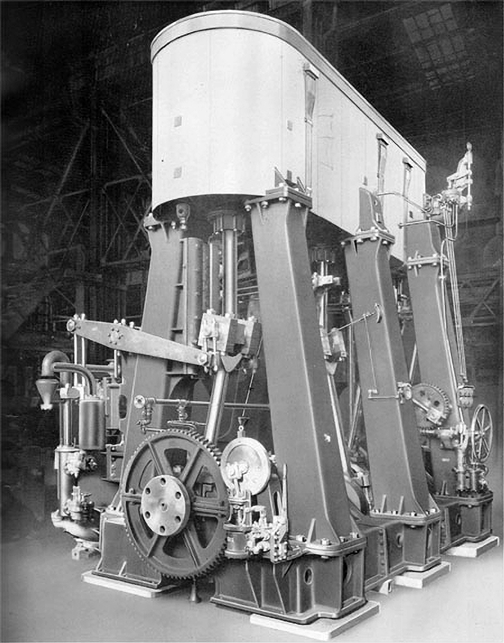
The engines were 23 feet in height and
weighed 250,000 lbs. There were 15,542 individual parts in the
engine. This was not like anything the company had produced in
peacetime and shows the Iron Fireman Manufacturing Company's ability to
adapt and then build such a massive device. Image from
Instructions for the operation and maintenance of 2500 I.H.P.-24
1/2-37-70 x 48"-76 R.P.M. vertical triple expansion marine steam engines
for the United States Maritime Commission EC2-S-C1 cargo vessels.
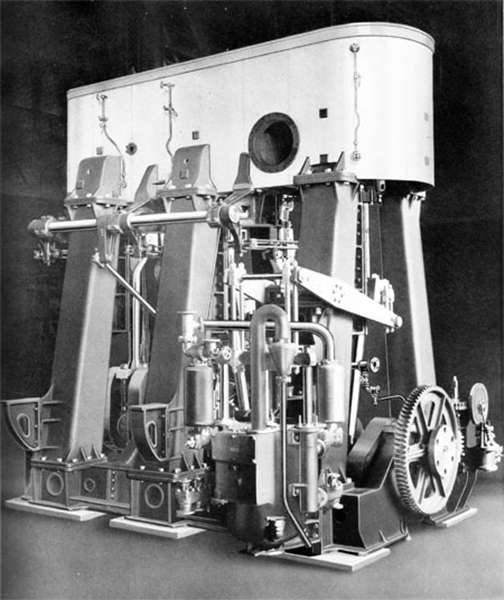
This image came from the Instructions for the
operation and maintenance of 2500 I.H.P.-24 1/2-37-70 x 48"-76 R.P.M.
vertical triple expansion marine steam engines for the United States
Maritime Commission EC2-S-C1 cargo vessels.
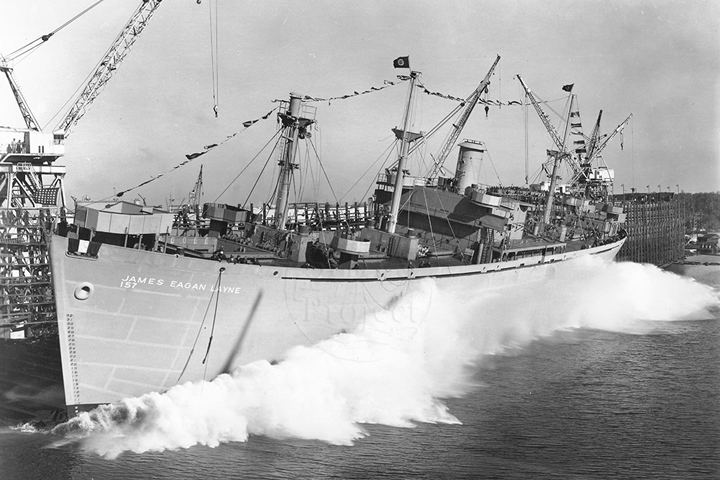
This launching of the Liberty ship James
Eagan Layne shows the type of vessel it was. Image courtesy of M.
Layne.
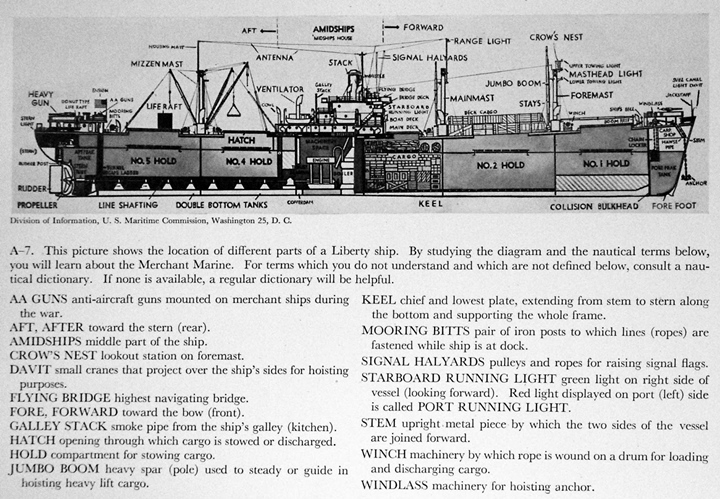
The engine was located in the center of the
ship. U.S. Maritime Commission image.

This image better shows that the propeller
shaft ran almost half the length of the ship. Image courtesy of
Wikipedia Commons.

Another diverse World War Two product of the
Iron Fireman Manufacturing Company was the T36 snow tractor. As
noted above, I photographed this at the 2014 MVP-HA National Convention
in Oshkosh, WI. Author's photo.
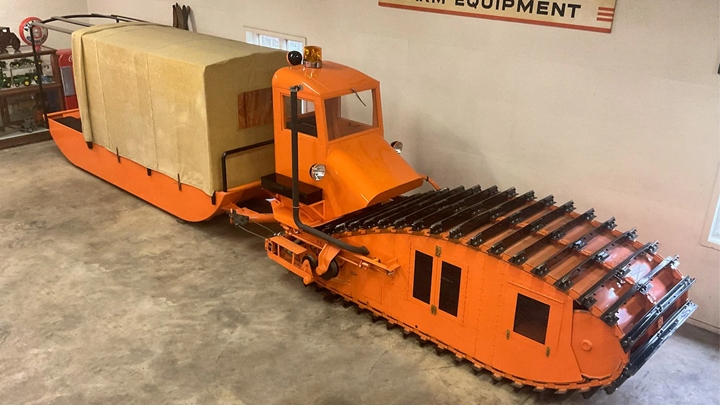
The T-36
was based
on the 1938 Monarch Sno-Motor developed by Theodore (T.P.)
Flynn who was a Forest Service employee. He was also a pioneer in
bulldozers and was involved in the creation of the Clark Airborne dozer.
Image courtesy of Silodrome added 12-8-2024.
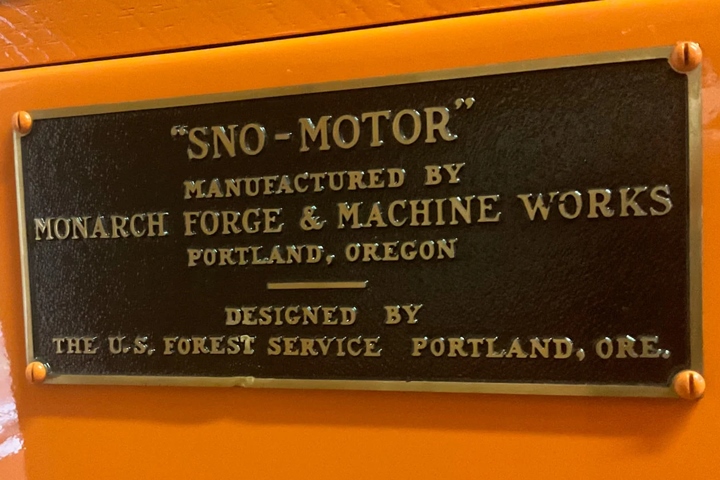
Monarch Forge & Machine Works was still in
business and part of the Oregon War Industries, Inc. in Portland, OR.
However, it apparently did not have the capacity to produce the number
of T-36s required for the war effort. It only had $486,000 in
major contracts during World War Two. It could also have been
producing important forgings for the other company in the Oregon War
Industries, Inc.
Image
courtesy of Silodrome added 12-8-2024.
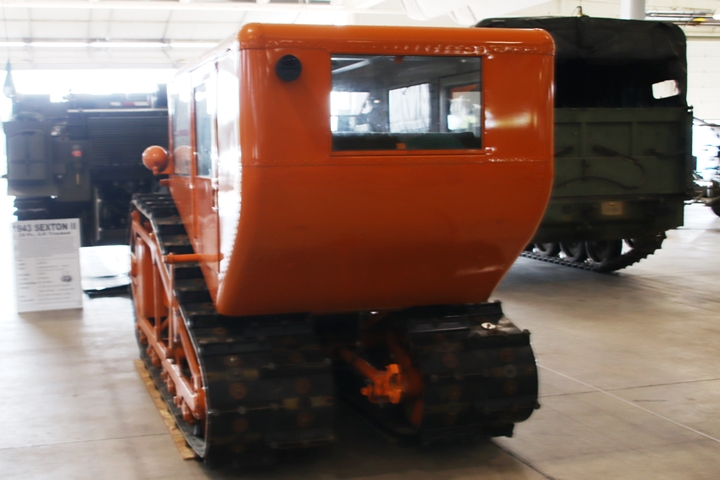
I was totally unaware of such a
vehicle and found this a welcome surprise at the convention.
Author's photo.

Table 3 shows that there were 36
accepted by Army Ordnance in 1944. Table 2 indicates the contract
amount for the 36 vehicles was $518,000 which is a cost of $14,889 per
unit. Author's photo.
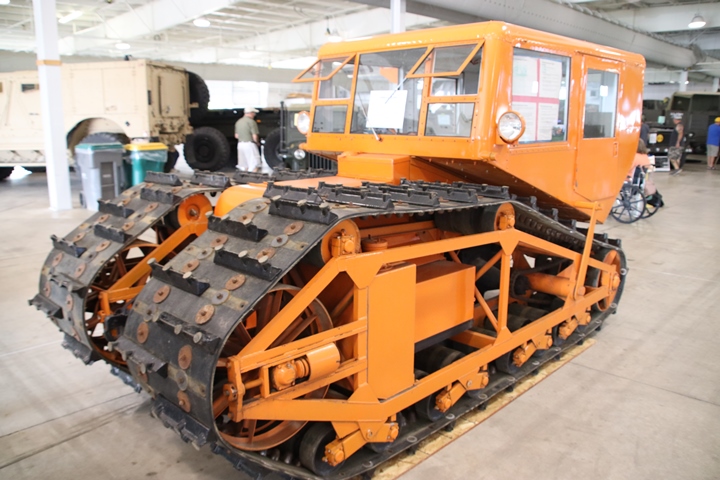
This is one of four T36s that still
exist. Author's photo.

Author's photo.

Author's photo.

Author's photo.
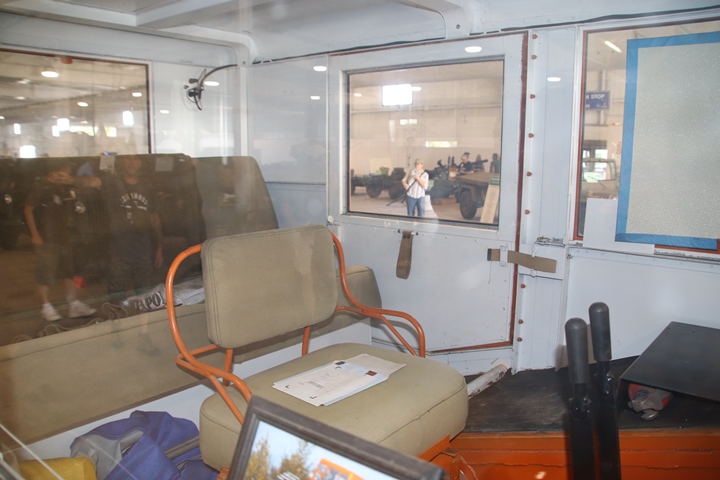
Author's photo.
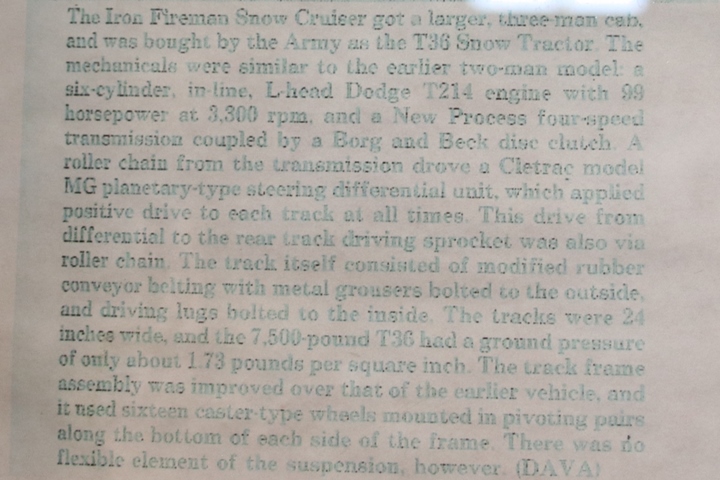
The owner had four information sheets placed
in one of the windows. I have included all four, as they are
comprehensive in providing information on this very rare and unique
vehicle. This one is from "U.S. Military Tracked Vehicles" by Fred
W. Crismon. Author's photo.
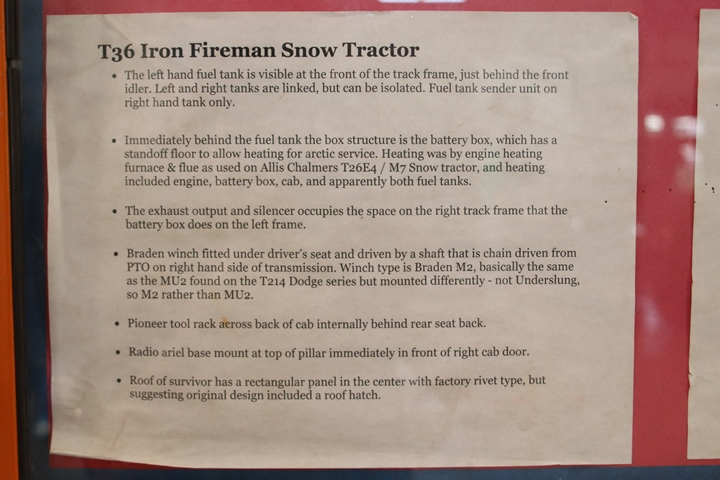
This and the next two information sheets are
by the vehicle's owner. Author's photo.
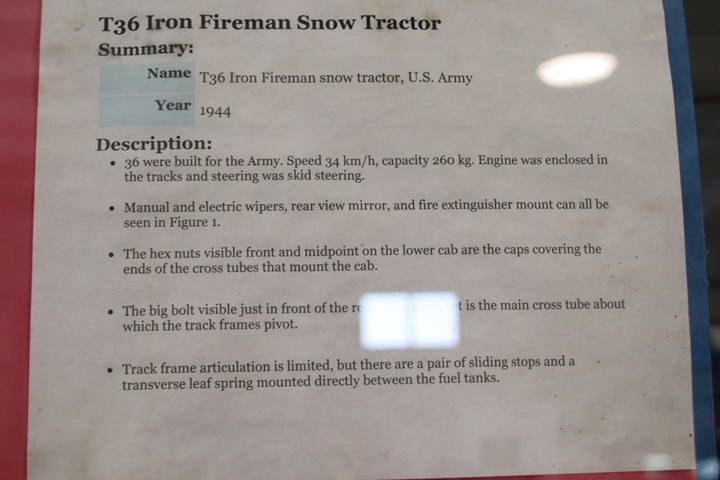
Author's photo.

Author's photo.
The Iron Fireman
Manufacturing Company Portland, OR Plant:
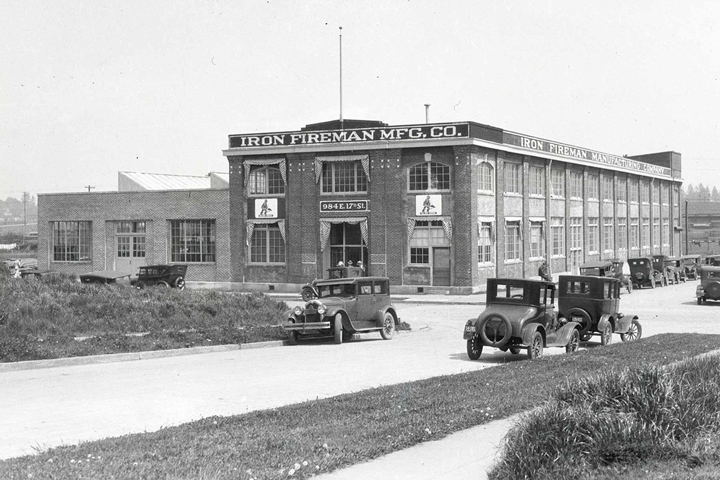
The original building at 984 SE 17th St.
Portland OR, was built in the 1920’s for the Iron Fireman. Two
Iron Fireman logos can be seen on the building. Image courtesy of
Iron Fireman Collective.
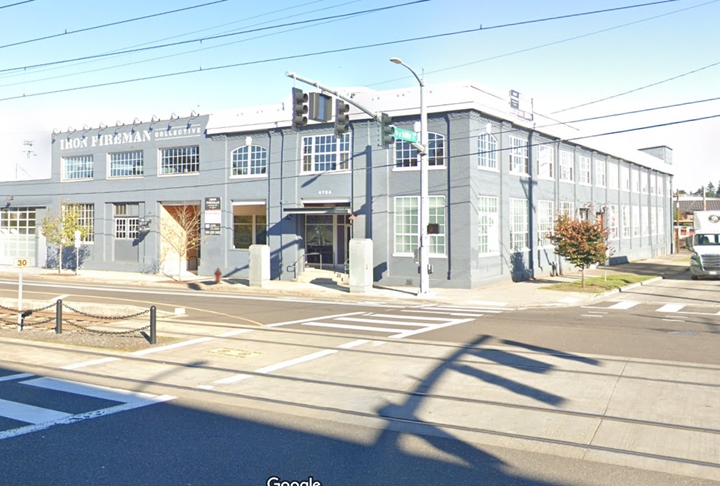
What is really cool is that the original Iron
Fireman Manufacturing Company building still exists and is in current
use. This photo replicating the photo above was taken by Google
Maps in June 2019.

The Iron Fireman Collective at 4784 SE 17th
Avenue, Portland, OR was established in 2016 as a tribute to the
original Iron Fireman factory building to provide spaces crafted for
makers, manufacturers, fabricators, innovators, and entrepreneurs. The
plant was fully renovated for modern day production. This 1920 146,000
SF building on the corner of SE 17th Avenue and SE Schiller Street
appears to be a nondescript two story restored factory building.
The building is in the same location it always has been. The
address system changed in the last 100 years. Image courtesy of
Google Maps.

This image of the back side of the factory shows the original red brick
that has not been repainted. Repainting old factories for being
repurposed is common as they make the buildings look better. Image
courtesy of Google Maps.

This and the next five photos are all
courtesy of Google Earth and give a 360 degree view of the factory.
All show that the Iron Fireman Manufacturing Company plant expanded to
fill one city block.




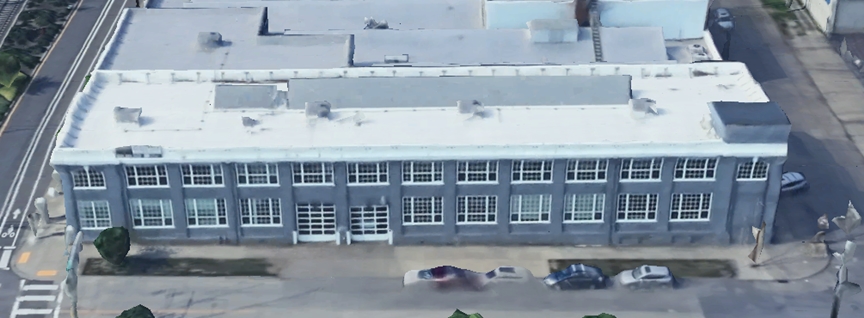
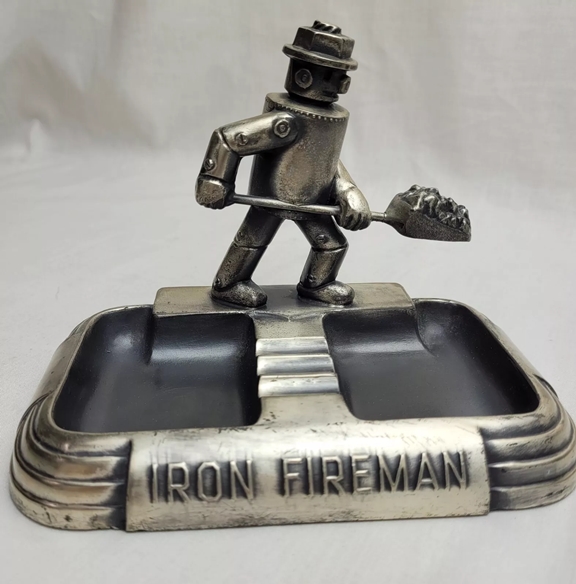
Iron Fireman ashtrays can be found on
today's online auction sites.
|































